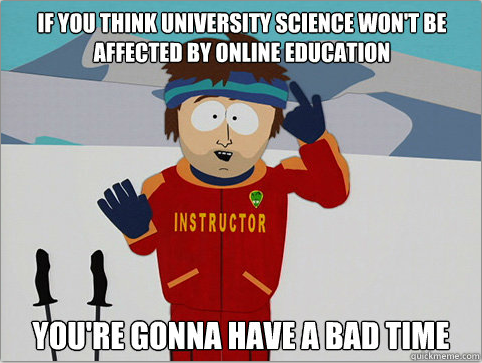National labs for all the sciences
29 May 2012Harvard, MIT, Stanford, and several other elite universities have all recently announced that they will be be offering free online courses. The courses will be massively open, taught by star professors, and supplemented with video lessons, embedded testing, and realtime feedback. This is surely good news for students who might not be able to access these resources otherwise, and it is an overall positive development for education. But what are the implications for scientists who conduct research in universities? And how will these developments affect the progress of scientific research?

Unless we correctly anticipate the changes, the implications for science might not be good, at least through the medium term. When elite universities offer classes for free, other universities will have difficulty convincing new students to enroll in their own traditional programs. Why sit through an expensive 9AM lecture at your local university when you could get the Harvard lecture for free, whenever you want? Yes, yes, students benefit from being physically present at a university: interactions with professors and other students are often irreplaceable. And yes, many universities will manage to survive in their traditional form. But as a matter of degree the future trends are clear: Online alternatives will become better, and in many cases they will offer real diplomas. As this happens, demand for traditional education at second-tier universities will decline, tuition revenue will dry up, and many excellent scientists could be laid off. In some cases, entire universities may shut down, just as many local newspapers have succumbed to competition from online journalism.
With so many good scientists out of work, the progress of science will slow down. While scientists who work on applied research may find employment in private industry, those who do basic research will not fare as well. Nonprofit research institutes may emerge as places for basic research, but donor-based funding is never guaranteed. Moreover, these nonprofits might only begin operations after a painful transition period.
This is where government can step in, anticipating the problem and preparing research institutes where scientists can work outside of a university setting. For the biological sciences, let’s start building more regional NIH campuses throughout America. In the physical sciences, let’s expand the national labs system. And for all the other sciences, let’s call for regional NSF campuses. Ideally, these initiatives will be paid for by increases in top-line budgets for science agencies. Or, if that is not an option, we could use the money saved in extramural research budgets, which will surely be trimmed as university scientists are laid off. Whatever the details, the larger scientific community must start preparing now for the coming tsunami of online education, before it’s too late.
